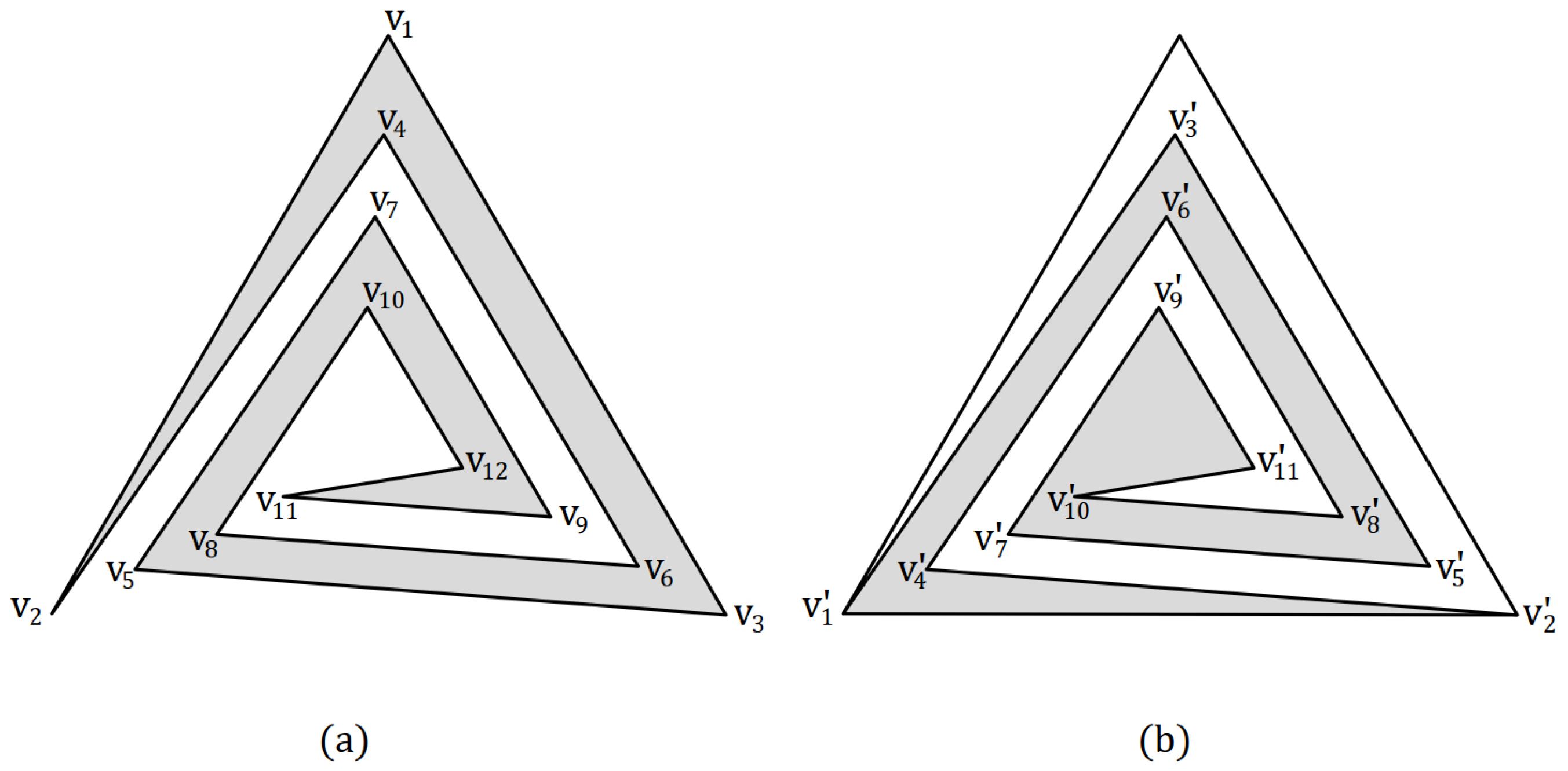Lower Bound for Sculpture Garden Problem: Localization of IoT Devices
Abstract
:1. Introduction
2. Sculpture Garden Problem and Applications
Upper and Lower Bounds
3. Helix Polygon
3.1. Construction of Helix
| Algorithm 1 Constructing Helix Polygon |
Input: Integer number as the number of vertices. Output: The Helix polygon .
|
3.2. Properties of Helix
3.3. Necessity of Natural Vertex Guards for Helix
4. Conclusions
Author Contributions
Funding
Institutional Review Board Statement
Informed Consent Statement
Data Availability Statement
Conflicts of Interest
References
- De Berg, M.; Van Kreveld, M.; Overmars, M.; Schwarzkopf, O.C. Computational Geometry; Springer: Berlin/Heidelberg, Germany, 2000. [Google Scholar]
- Eppstein, D.; Goodrich, M.T.; Sitchinava, N. Guard placement for efficient point-in-polygon proofs. In Proceedings of the Twenty-Third Annual Symposium on Computational Geometry; ACM: Gyeongju, Republic of Korea, 2007; pp. 27–36. [Google Scholar]
- Eppstein, D.; Goodrich, M.T.; Sitchinava, N. Guard placement for wireless localization. arXiv 2006, arXiv:cs/0603057. [Google Scholar]
- Christ, T.; Hoffmann, M.; Okamoto, Y. Natural wireless localization is NP-hard. In Abstracts 25th European Workshop Computational Geometry; Citeseer: Brussels, Belgium, 2009; pp. 175–178. [Google Scholar]
- Christ, T.; Hoffmann, M. Wireless Localization with Vertex Guards is NP-hard. In CCCG; Citeseer: Vancouver, BC, Canada, 2009; pp. 149–152. [Google Scholar]
- Dobkin, D.; Guibas, L.; Hershberger, J.; Snoeyink, J. An Efficient Algorithm for Finding the CSG Representation of a Simple Polygon; ACM: Atlanta, GA, USA, 1988; Volume 22, Number 4. [Google Scholar]
- Füredi, Z.; Kleitman, D.J. The prison yard problem. Combinatorica 1994, 14, 287–300. [Google Scholar] [CrossRef]
- Estivill-Castro, V.; O’Rourke, J.; Urrutia, J.; Xu, D. Illumination of polygons with vertex lights. Inf. Process. Lett. 1995, 56, 9–13. [Google Scholar] [CrossRef]
- Steiger, W.; Streinu, I. Illumination by floodlights. Comput. Geom. 1998, 10, 57–70. [Google Scholar] [CrossRef] [Green Version]
- Aichholzer, O.; Fabila-Monroy, R.; Flores-Penaloza, D.; Hackl, T.; Urrutia, J.; Vogtenhuber, B. Modem illumination of monotone polygons. Comput. Geom. 2018, 68, 101–118. [Google Scholar] [CrossRef] [Green Version]
- Ballinger, B.; Benbernou, N.; Bose, P.; Damian, M.; Demaine, E.D.; Dujmović, V.; Flatland, R.; Hurtado, F.; Iacono, J.; Lubiw, A. Coverage with k-transmitters in the presence of obstacles. J. Comb. Optim. 2013, 25, 208–233. [Google Scholar] [CrossRef] [Green Version]
- Crepaldi, B.E.; de Rezende, P.J.; de Souza, C.C. An Efficient Exact Algorithm for the Natural Wireless Localization Problem. In CCCG; Carleton University: Waterloo, ON, Canada, 2013. [Google Scholar]
- Crepaldi, B.E.; de Rezende, P.J.; de Souza, C.C. Solving the natural wireless localization problem to optimality efficiently. Comput. Geom. 2015, 48, 370–379. [Google Scholar] [CrossRef]
- Cano, J.; Tóth, C.D.; Urrutia, J. A tight bound for point guards in piecewise convex art galleries. Comput. Geom. 2013, 46, 945–958. [Google Scholar] [CrossRef]
- Karavelas, M.I.; Tóth, C.D.; Tsigaridas, E.P. Guarding curvilinear art galleries with vertex or point guards. Comput. Geom. 2009, 42, 522–535. [Google Scholar] [CrossRef] [Green Version]
- Karavelas, M.I. Guarding curvilinear art galleries with edge or mobile guards via 2-dominance of triangulation graphs. Comput. Geom. 2011, 44, 20–51. [Google Scholar] [CrossRef] [Green Version]
- Damian, M.; Flatland, R.; O’Rourke, J.; Ramaswami, S. A new lower bound on guard placement for wireless localization. arXiv 2007, arXiv:0709.3554. [Google Scholar]
- Christ, T.; Hoffmann, M.; Okamoto, Y.; Uno, T. Improved bounds for wireless localization. In Algorithm Theory-SWAT; Springer: Berlin/Heidelberg, Germany, 2008; pp. 77–89. [Google Scholar]
- Eskandari, M.; Mohades, A.; Bigham, B.S.B. On the Number of Guards in sculpture garden problem. World Appl. Sci. J. 2010, 10, 1255–1263. [Google Scholar]









Disclaimer/Publisher’s Note: The statements, opinions and data contained in all publications are solely those of the individual author(s) and contributor(s) and not of MDPI and/or the editor(s). MDPI and/or the editor(s) disclaim responsibility for any injury to people or property resulting from any ideas, methods, instructions or products referred to in the content. |
© 2023 by the authors. Licensee MDPI, Basel, Switzerland. This article is an open access article distributed under the terms and conditions of the Creative Commons Attribution (CC BY) license (https://creativecommons.org/licenses/by/4.0/).
Share and Cite
Eskandari, M.; Sadeghi Bigham, B.; Zahedi-Seresht, M. Lower Bound for Sculpture Garden Problem: Localization of IoT Devices. Appl. Sci. 2023, 13, 2597. https://doi.org/10.3390/app13042597
Eskandari M, Sadeghi Bigham B, Zahedi-Seresht M. Lower Bound for Sculpture Garden Problem: Localization of IoT Devices. Applied Sciences. 2023; 13(4):2597. https://doi.org/10.3390/app13042597
Chicago/Turabian StyleEskandari, Marzieh, Bahram Sadeghi Bigham, and Mazyar Zahedi-Seresht. 2023. "Lower Bound for Sculpture Garden Problem: Localization of IoT Devices" Applied Sciences 13, no. 4: 2597. https://doi.org/10.3390/app13042597







